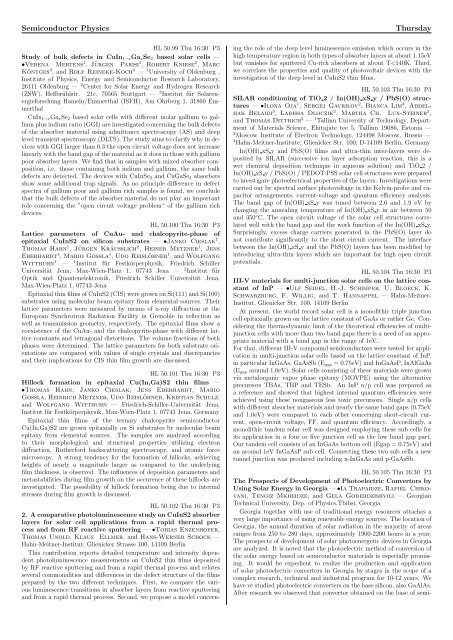HL 50 Poster II - DPG-Verhandlungen
HL 50 Poster II - DPG-Verhandlungen
HL 50 Poster II - DPG-Verhandlungen
You also want an ePaper? Increase the reach of your titles
YUMPU automatically turns print PDFs into web optimized ePapers that Google loves.
Semiconductor Physics Thursday<br />
<strong>HL</strong> <strong>50</strong>.99 Thu 16:30 P3<br />
Study of bulk defects in CuIn1−xGaxSe2 based solar cells —<br />
•Verena Mertens 1 , Jürgen Parisi 1 , Robert Kniese 2 , Marc<br />
Köntges 3 , and Rolf Reineke-Koch 3 — 1 University of Oldenburg ,<br />
Institute of Physics, Energy and Semiconductor Research Laboratory,<br />
26111 Oldenburg — 2 Center for Solar Energy and Hydrogen Research<br />
(ZSW), Heßbrühlstr. 21c, 70565 Stuttgart — 3 Institut für Solarenergieforschung<br />
Hameln/Emmerthal (ISFH), Am Ohrberg 1, 31860 Emmerthal<br />
CuIn1−xGaxSe2 based solar cells with different molar gallium to gallium<br />
plus indium ratio (GGI) are investigated concerning the bulk defects<br />
of the absorber material using admittance spectroscopy (AS) and deep<br />
level transient spectroscopy (DLTS). The study aims to clarify why in devices<br />
with GGI larger than 0.3 the open circuit voltage does not increase<br />
linearly with the band gap of the material as it does in those with gallium<br />
poor absorber layers. We find that in samples with mixed absorber composition,<br />
i.e. those containing both indium and gallium, the same bulk<br />
defects are detected. The devices with CuInSe2 and CuGaSe2 absorbers<br />
show some additional trap signals. As no principle difference in defect<br />
spectra of gallium poor and gallium rich samples is found, we conclude<br />
that the bulk defects of the absorber material do not play an important<br />
role concerning the ”open circuit voltage problem“ of the gallium rich<br />
devices.<br />
<strong>HL</strong> <strong>50</strong>.100 Thu 16:30 P3<br />
Lattice parameters of CuAu- and chalcopyrite-phase of<br />
epitaxial CuInS2 on silicon substrates — •Janko Cieslak 1 ,<br />
Thomas Hahn 1 , Jürgen Kräußlich 2 , Heiner Metzner 1 , Jens<br />
Eberhardt 1 , Mario Gossla 1 , Udo Reislöhner 1 , and Wolfgang<br />
Witthuhn 1 — 1 Institut für Festkörperphysik, Friedrich Schiller<br />
Universität Jena, Max-Wien-Platz 1, 07743 Jena — 2 Institut für<br />
Optik und Quantenelektronik, Friedrich Schiller Universität Jena,<br />
Max-Wien-Platz 1, 07743 Jena<br />
Epitaxial thin films of CuInS2 (CIS) were grown on Si(111) and Si(100)<br />
substrates using molecular beam epitaxy from elemental sources. Their<br />
lattice parameters were measured by means of x-ray diffraction at the<br />
European Synchrotron Radiation Facility in Grenoble in reflection as<br />
well as transmission geometry, respectively. The epitaxial films show a<br />
coexistence of the CuAu- and the chalcopyrite-phase with different lattice<br />
constants and tetragonal distortions. The volume fractions of both<br />
phases were determined. The lattice parameters for both substrate orientations<br />
are compared with values of single crystals and discrepancies<br />
and their implications for CIS thin film growth are discussed.<br />
<strong>HL</strong> <strong>50</strong>.101 Thu 16:30 P3<br />
Hillock formation in epitaxial Cu(In,Ga)S2 thin films —<br />
•Thomas Hahn, Janko Cieslak, Jens Eberhardt, Mario<br />
Gossla, Heinrich Metzner, Udo Reislöhner, Kristian Schulz,<br />
and Wolfgang Witthuhn — Friedrich-Schiller-Universität Jena,<br />
Institut für Festkörperphysik, Max-Wien-Platz 1, 07743 Jena, Germany<br />
Epitaxial thin films of the ternary chalcopyrite semiconductor<br />
Cu(In,Ga)S2 are grown epitaxially on Si substrates by molecular beam<br />
epitaxy from elemental sources. The samples are analyzed according<br />
to their morphological and structural properties utilizing electron<br />
diffraction, Rutherford backscattering spectroscopy, and atomic force<br />
microscopy. A strong tendency for the formation of hillocks, achieving<br />
heights of nearly a magnitude larger as compared to the underlying<br />
film thickness, is observed. The influences of deposition parameters and<br />
metastabilities during film growth on the occurence of these hillocks are<br />
investigated. The possibility of hillock formation being due to internal<br />
stresses during film growth is discussed.<br />
<strong>HL</strong> <strong>50</strong>.102 Thu 16:30 P3<br />
2. A comparative photoluminescence study on CuInS2 absorber<br />
layers for solar cell applications from a rapid thermal process<br />
and from RF reactive sputtering — •Tobias Enzenhofer,<br />
Thomas Unold, Klaus Ellmer, and Hans-Werner Schock —<br />
Hahn-Meitner-Institut, Glienicker Strasse 100, 14109 Berlin<br />
This contribution reports detailed temperature and intensity dependent<br />
photoluminescence measurements on CuInS2 thin films deposited<br />
by RF reactive sputtering and from a rapid thermal process and relates<br />
several commonalities and differences in the defect structure of the films<br />
prepared by the two different techniques. First, we compare the various<br />
luminescence transitions in absorber layers from reactive sputtering<br />
and from a rapid thermal process. Second, we propose a model concern-<br />
ing the role of the deep level luminescence emission which occurs in the<br />
high temperature region in both types of absorber layers at about 1.15eV<br />
but vanishes for sputtered Cu-rich absorbers at about T

















